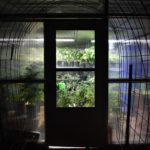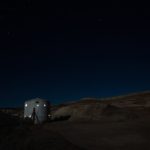Journalist Report – March 4th
Journalist report, 03/04/18: Second day off / Special edition 2: About the MegaARES
Our second day off was quite welcomed today after such a busy week. All the crew could catch up some sleep, and spent some time chilling in the Hab, around films and card games. As intended, I will talk today about our second large outside experience and its instrument: the MegaARES.
The Mega Atmospheric Relaxation and Electric field Sensor is an instrument developed by Grégoire Déprezand his team of researchers at LATMOS (French atmosphere and spatial observations laboratory). Several versions of ARES have been developed before, the most advanced being the MicroARES, which was part of a group of sensors on the DREAMS payload of the ExoMars Schiaparelli module which attempted an automated landing on Mars on 19 October 2016. However, the signal was unexpectedly lost shortly before the planned landing time, and Schiaparelli crashed. MicroARES was thus destroyed and could not take any measure on Mars.
This device is able to record the electric field in favorable weather conditions and is precise enough to catch electric field variations phenomenon known as Schuman and Transverse Resonances. On a planet, such electric phenomenon occurring in the atmosphere could indeed have a major role and link with the planet’s climate and chemistry. Being able to measure the electric field precisely is thus a quite interesting challenge for planetology. Utah Desert’s electric field matches Mars’ atmospheric one on several points. Interesting phenomenon hypothesized to occur on Mars could indeed be caught in the Utah Desert.
Scientists of the LATMOS team will have to wait for the next Martian mission to deploy their instrument, and want to use the time left to improve its performance. Analog mission are thus their best opportunity to work on the device. Through MegaARES, specially developed for Earth measures, data recording, data analyzing and hardware can be tested for a certain length of time at MDRS station. The instrument is used simultaneously with the LOAC, in order to study cross effect between sand and electric field dynamics. LOAC and MegaARES will thus give a large and precise database which could be used for future experiments on the MDRS.
We would like to thank Grégoire Déprez and his team for having accepted to lend us this instrument, and for their trust in us for its use.
Alexandre Martin, Crew 189 Journalist, with the help of Gabriel Payen, Crew 189 Engineer, in charge of the MegaARES experiment.
Journalist Report – March 4th
Journalist report, 03/04/18: Second day off / Special edition 2: About the MegaARES
Our second day off was quite welcomed today after such a busy week. All the crew could catch up some sleep, and spent some time chilling in the Hab, around films and card games. As intended, I will talk today about our second large outside experience and its instrument: the MegaARES.
The Mega Atmospheric Relaxation and Electric field Sensor is an instrument developed by Grégoire Déprezand his team of researchers at LATMOS (French atmosphere and spatial observations laboratory). Several versions of ARES have been developed before, the most advanced being the MicroARES, which was part of a group of sensors on the DREAMS payload of the ExoMars Schiaparelli module which attempted an automated landing on Mars on 19 October 2016. However, the signal was unexpectedly lost shortly before the planned landing time, and Schiaparelli crashed. MicroARES was thus destroyed and could not take any measure on Mars.
This device is able to record the electric field in favorable weather conditions and is precise enough to catch electric field variations phenomenon known as Schuman and Transverse Resonances. On a planet, such electric phenomenon occurring in the atmosphere could indeed have a major role and link with the planet’s climate and chemistry. Being able to measure the electric field precisely is thus a quite interesting challenge for planetology. Utah Desert’s electric field matches Mars’ atmospheric one on several points. Interesting phenomenon hypothesized to occur on Mars could indeed be caught in the Utah Desert.
Scientists of the LATMOS team will have to wait for the next Martian mission to deploy their instrument, and want to use the time left to improve its performance. Analog mission are thus their best opportunity to work on the device. Through MegaARES, specially developed for Earth measures, data recording, data analyzing and hardware can be tested for a certain length of time at MDRS station. The instrument is used simultaneously with the LOAC, in order to study cross effect between sand and electric field dynamics. LOAC and MegaARES will thus give a large and precise database which could be used for future experiments on the MDRS.
We would like to thank Grégoire Déprezand and his team for having accepted to lend us this instrument, and for their trust in us for its use.
Alexandre Martin, Crew 189 Journalist, with the help of Gabriel Payen, Crew 189 Engineer, in charge of the MegaARES experiment.
Operations Report – March 4th
Crew 189 Operations Report 4March2018
SOL: 14
Name of person filing report: Gabriel PAYEN
Non-nominal systems: –
Notes on non-nominal systems: –
Generator (hours run): Turned off at 08:45 and turned on at 1814
Solar— SOC 88 % (Before generator is run at night)
Diesel – 49 %
Propane – 25 psi.
Ethanol Free Gasoline (5 Gallon containers for ATV) – 3 gallons.
Water (trailer) – 0 gallons.
Water (static) – 550 gallons (100%)
Note : Dr Rupert and Atila realized that the tanks are 550 gallons one instead of 500.
Trailer to Static Pump used – NO
Water (loft) – Static to Loft Pump used – YES
Water Meter: 131 656.6
Toilet tank emptied: NO
ATV’s Used: NO
Oil Added : YES
ATV Fuel Used: Gals
Hours the ATVs were Used today: –
Notes on ATVs: The ATVs are full and ready to go
Deimos rover used: NO
Hours:
Beginning charge:
Ending charge:
Currently charging:
Sojourner rover used: ASSIGNED TO DIRECTOR
Hours:
Beginning charge:
Ending charge:
Currently charging:
Spirit rover used: NO
Hours:
Beginning charge:
Ending charge:
Currently charging:
Opportunity rover used: NO
Hours:
Beginning charge:
Ending charge:
Currently charging:
Curiosity rover used: NO
Hours:
Beginning charge:
Ending charge:
Currently charging:
HabCar used and why, where : Used to get 120 water, for garbage and to stored parts of the aquaponics system
General notes and comments: –
Summary of internet: –
Summary of suits and radios: –
Summary of Hab operations: –
Summary of GreenHab operations:
Summary of ScienceDome operations: –
Summary of RAMM operations:-
Summary of health and safety issues: –
Questions, concerns and requests to Mission Support: –
GreenHab Report – March 4th
AUCLAIR Jérémy
4th March 2018
Environmental control:
(door closed)
Heating once the sun was down
80 % Shade cloth on
Average temperatures:
Around 24 °C at 11:30 am, around 18 °C the rest of the day
Hours of supplemental light: from 7pm to 9pm
Changes to crops: 9 cherry tomatoes
Daily water usage for crops: around 10 gallons
Time(s) of watering for crops: 11:30 am and 6pm
Narrative: I was a bit surprised and sad to find out that the salads I planned to harvest for dinner had been taken, the crew was looking forward to eating some greens. Perhaps next time the Martians could tell us in advance, so we can plan our meals accordingly.
Support/supplies needed: none
Sol Summary – March 4th
Sol 14
Summary Title: The last Sunday on Mars
Author: Victoria Da-Poian
Mission Status: All nominal
Sol Activity Summary: Today was our second day-off and our last Sunday on Mars. We took time for ourselves and worked on some experiments. This day-off was really appreciated by the whole crew.
Look Ahead Plan: Tomorrow will be the beginning of our last week on Mars. Everyone seems really motivated to work hard during these last days and to welcome the journalists on Tuesday!
Anomalies in work: None
Weather: Sunny and windy
Crew Physical Status: Fine
EVA: None
Reports to be file:
Commander
Journalist
Engineering
Greenhab Officer
Support Requested: None
Commander Report – March 4th
Hi Jennifer, Hi Capcom,
Here the Crew 189 Commander Report 04Mar2018
Sol 14
Title: Third and last Martian Sunday
Dear Earth,
Yesterday, a French journalist, Laure Andrillon, joined the crew for our typical tasks: physical training, breakfast, morning EVA to check the air-sensors experiments and explore the vicinity, EVA debriefing, experiments and personal interview… It was really nice to see a new face after two weeks confined with the same people.
Today was our third Martian Sunday and our second day-off (really needed and appreciated by the whole crew). There was no need to wake up early in the morning, so our Saturday evening was dedicated to cards games (altogether) and lot of fun! As I do not need many sleeping hours, I woke up naturally at 8am, and I was so happy to have my breakfast in this quiet station once again! Living with six men is (quite) noisy sometimes. After this peaceful moment, I went to bedroom, watching the martian environment from my window. The other crewmembers cooked a nice brunch and then everyone took time for themselves (shower, movies, reading, playing…) Louis, Gabriel and I played cards again (we are addicted to the new game we learnt called “Hanabi”). Even if it was our day-off, as I miss practicing sports, I convinced Louis to make our physical training this afternoon, and we did well! (but perhaps the other crewmembers will think we are crazy).
After this, Jérémy did his human factors experiment and everyone was busy: we worked on reports or we cooked.
Tomorrow will begin the last week of our mission on this beautiful planet! Let’s work and have fun altogether for these last days!
Ad Astra!
Victoria Da-Poian
Commander of the still-very-motivated Crew 189






You must be logged in to post a comment.